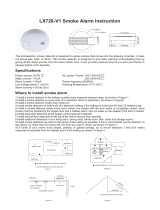
5
premises nor move away from the open door/window until the emergency
services responders have arrived, the premises have been aired out, and your
alarm remains in its normal condition.
(4) After following steps 1–3, if your alarm reactivates within a 24 hour period,
repeat steps 1–3 and call a qualified appliance technician to investigate for
sources of CO from fuel burning equipment and appliances, and inspect for
proper operation of this equipment. If problems are identified during this
inspection, have the equipment serviced immediately. Note any combustion
equipment not inspected by the technician and consult the manufacturers’
instructions, or contact the manufacturers directly, for more information about
CO safety and this equipment. Make sure that motor vehicles are not, and have not
been, operating in an attached garage or adjacent to the residence.
WARNING: Smoke detectors CANNOT provide warnings for fires resulting from
explosions, smoking in bed or other furniture, ignition of flammable liquids, vapors
and gasses, children playing with matches or lighters.
WARNING: Smoke detectors are not to be used with detector guards unless the
combination has been evaluated and found suitable for that purpose.
CAUTION: Early warning fire detection is best achieved by the installation of fire
detection equipment in all rooms and areas of the household as follows:
A smoke alarm or detector installed in each separate sleeping room, outside of each
separate sleeping area, in the immediate vicinity of the sleeping rooms, and on each
level of the dwelling unit, including basements and heat or smoke detectors in living
rooms, dining rooms, kitchens, hallways, attics, furnace rooms, closets, utility and
storage rooms, and attached garages.




















